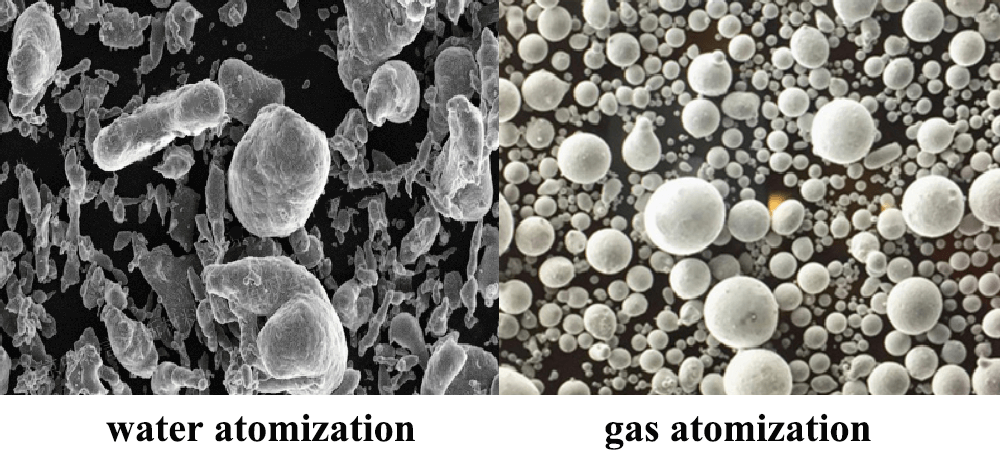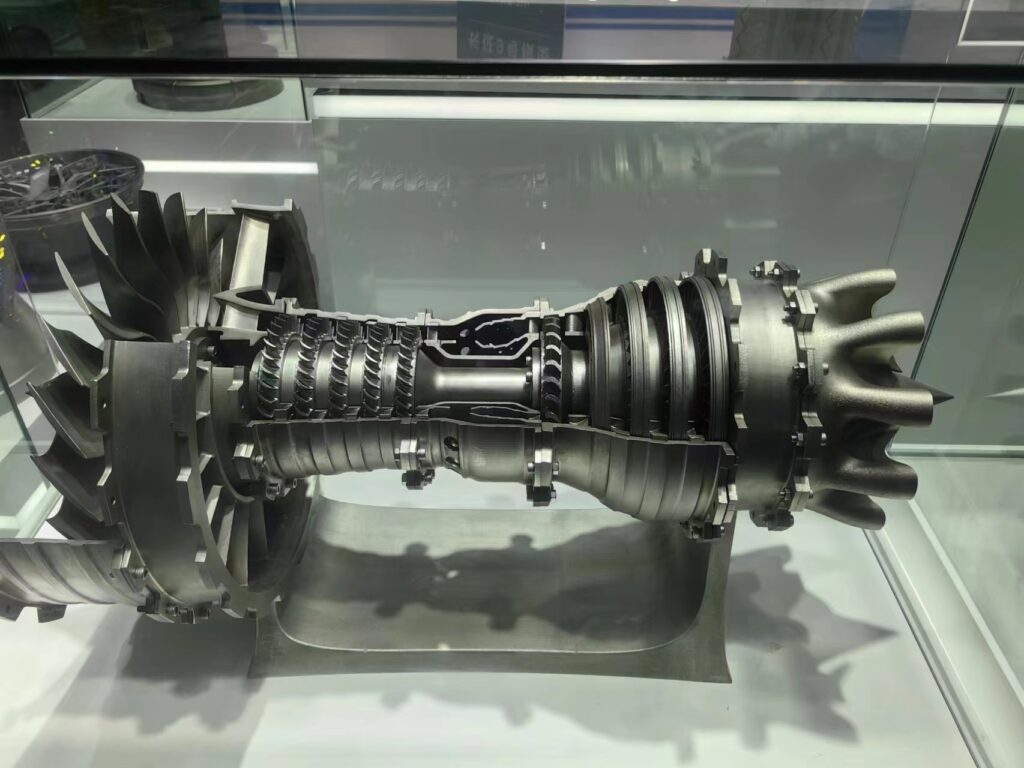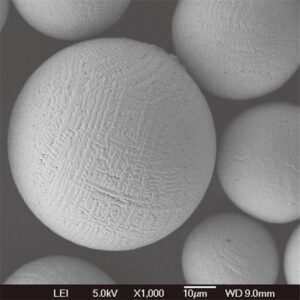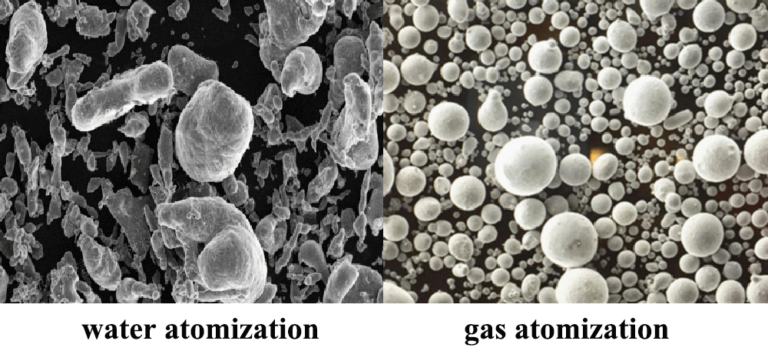Tổng quan
Metal powder gas atomization equipment is an industrial system used to produce fine, spherical metal powders by disintegrating a molten metal stream with high-pressure inert gas jets. These metal powders find extensive applications in additive manufacturing processes like 3D printing, as well as in various other industries such as automotive, aerospace, and chemical processing.
What is Metal Powder Gas Atomization Equipment?

Metal powder gas atomization equipment is a specialized industrial apparatus designed to produce high-quality metal powders through a process called gas atomization. In this process, a molten metal stream is disintegrated into fine droplets by impinging high-velocity jets of inert gas, typically argon or nitrogen.
The equipment consists of several key components: a metal melting furnace, a tundish (a vessel that holds the molten metal), a pour tube, and a gas atomization chamber. The molten metal is poured from the furnace into the tundish, where it flows through the pour tube and enters the atomization chamber.
Inside the atomization chamber, the molten metal stream encounters a series of high-pressure gas jets, which impinge on the metal stream at supersonic velocities. The intense kinetic energy of the gas jets disrupts the molten metal stream, causing it to break up into countless tiny droplets. These droplets rapidly solidify into fine, spherical metal particles as they travel through the chamber, aided by the cooling effect of the inert gas.
The resulting metal powder is collected at the bottom of the chamber, while the gas and any remaining metal vapor are expelled through exhaust systems. The powder is then subjected to various post-processing steps, such as sieving, to ensure uniform particle size distribution and remove any irregularities or impurities.
Metal Powder Gas Atomization Equipment application

| Ứng dụng | Sự miêu tả |
|---|---|
| Additive Manufacturing (3D Printing) | Metal powders produced by gas atomization are widely used in additive manufacturing processes like selective laser sintering (SLS), direct metal laser sintering (DMLS), and electron beam melting (EBM) to create complex, high-precision metal components. |
| Đúc kim loại (MIM) | Gas atomized metal powders are used in metal injection molding, a process that combines the versatility of plastic injection molding with the strength and durability of metals. |
| Lớp phủ phun nhiệt | Gas atomized powders are used in thermal spray processes to apply wear-resistant, corrosion-resistant, or insulating coatings on various substrates. |
| Luyện kim bột | Gas atomized metal powders are used in powder metallurgy processes to produce high-performance components with unique material properties. |
| Welding and Brazing | Fine metal powders are used as filler materials in various welding and brazing applications. |
How Does Metal Powder Gas Atomization Equipment Work?

The basic principle behind metal powder gas atomization equipment is the conversion of a molten metal stream into fine, spherical particles through the impingement of high-velocity gas jets. The process can be broken down into several key steps:
- Melting: The desired metal or alloy is melted in a furnace at a temperature that ensures complete liquefaction and homogeneity. The molten metal is then transferred to a tundish, which acts as a reservoir for the atomization process.
- Pouring: The molten metal is poured from the tundish through a pour tube, creating a continuous stream that enters the atomization chamber.
- Nguyên tử hóa: Inside the atomization chamber, the molten metal stream encounters a series of high-pressure gas jets, typically arranged in a concentric or annular pattern around the metal stream. These gas jets, which are fed by an external gas supply system, impinge on the metal stream at supersonic velocities, causing it to disintegrate into countless tiny droplets.
- Droplet Formation and Solidification: As the molten metal stream breaks up, the resulting droplets rapidly solidify into fine, spherical particles due to the cooling effect of the inert gas environment. The size and morphology of the particles are influenced by various factors, such as the gas pressure, gas-to-metal ratio, and the physical properties of the molten metal.
- Powder Collection: The solidified metal powder particles are collected at the bottom of the atomization chamber, where they are typically cooled further before being transferred to a powder collection system.
- Gas Handling: The inert gas used for atomization, along with any residual metal vapor, is expelled from the chamber through exhaust systems, which may include filters and scrubbers to remove any contaminants.
- Powder Processing: The collected metal powder may undergo additional processing steps, such as sieving, to ensure a uniform particle size distribution and remove any irregularities or impurities. The powder may also be subjected to various characterization tests to assess its properties, such as particle size, morphology, and chemical composition.
The gas atomization process is highly versatile and can be used to produce powders from a wide range of metals and alloys, including iron, nickel, aluminum, titanium, and various superalloys. The equipment can be designed and optimized for different production scales, ranging from laboratory-scale research units to large-scale industrial production facilities.
Metal Powders Produced by Gas Atomization
Gas atomization is a widely used technique for producing high-quality metal powders with excellent characteristics for various applications. The metal powders produced by this process exhibit several desirable properties:
- Spherical Morphology: The rapid solidification of molten metal droplets in the gas atomization process results in highly spherical particles. This spherical shape is beneficial for applications that require good flowability, such as additive manufacturing processes like 3D printing.
- Narrow Particle Size Distribution: The gas atomization process allows for precise control over particle size distribution, enabling the production of powders with narrow size ranges tailored to specific application requirements.
- Độ tinh khiết cao: The use of inert gas atmospheres, such as argon or nitrogen, in the atomization chamber prevents oxidation and contamination, resulting in high-purity metal powders.
- Consistent Chemistry: The rapid solidification of molten metal droplets in gas atomization preserves the chemical composition of the alloy, ensuring consistent material properties in the final powder.
- Improved Mechanical Properties: The rapid solidification rates in gas atomization can lead to the formation of metastable phases or fine microstructures, resulting in enhanced mechanical properties like strength and ductility.
- Versatility: Gas atomization can be used to produce powders from a wide range of metals and alloys, including iron, nickel, aluminum, titanium, and various superalloys, making it a versatile technique for various industrial applications.
Metal Powder Gas Atomization Equipment benefits
| Benefit | Sự miêu tả |
|---|---|
| Consistent Quality | Gas atomized powders exhibit consistent particle size, shape, and chemical composition, ensuring reliable performance in downstream applications. |
| Độ tinh khiết cao | The inert gas environment and rapid solidification prevent oxidation and contamination, resulting in high-purity metal powders. |
| Tailored Properties | Process parameters can be adjusted to tailor the particle size distribution, morphology, and microstructure of the powders for specific application requirements. |
| Versatility | Gas atomization can be used to produce powders from a wide range of metals and alloys, making it suitable for various industrial applications. |
| Improved Flowability | The spherical shape of gas atomized powders enhances their flowability, which is crucial for processes like additive manufacturing and powder metallurgy. |
| Environmentally Friendly | Gas atomization does not involve the use of hazardous chemicals or generate significant waste, making it a relatively environmentally friendly process. |
Different Types of Metal Powder Gas Atomization Equipment
Metal powder gas atomization equipment can be classified into several types based on their design, production capacity, and the specific atomization process employed. Here are some of the most common types:
- Free-Fall Gas Atomization: In this type, the molten metal stream is atomized by gas jets as it falls vertically through the atomization chamber. Free-fall gas atomization is widely used for producing powders on a large scale and is suitable for a wide range of metals and alloys.
- Close-Coupled Gas Atomization: This design features a tundish positioned close to the atomization chamber, minimizing the distance between the molten metal stream and the gas jets. Close-coupled gas atomization offers better control over particle size distribution and is often used for producing fine powders.
- Confined Gas Atomization: In this type, the atomization process takes place within a confined chamber, allowing for better control over gas flow and enabling the production of ultra-fine powders with narrow size distributions.
- Vacuum Gas Atomization: This process involves atomizing the molten metal stream in a vacuum environment, preventing oxidation and contamination during powder production. Vacuum gas atomization is particularly useful for producing reactive metal powders and high-purity alloy powders.
- Centrifugal Gas Atomization: In this design, the molten metal is spun at high speeds and atomized by gas jets, resulting in a wider particle size distribution compared to other methods. Centrifugal gas atomization is often used for producing coarser powders or spray-forming applications.
- Electrode Induction Gas Atomization (EIGA): This specialized technique involves melting the metal using an induction coil and atomizing the molten metal directly from the electrode tip, allowing for precise control over the atomization process and minimizing contamination.
- Rotating Disk Gas Atomization: In this method, the molten metal is poured onto a rotating disk, where it is atomized by gas jets. This technique is suitable for producing powders with a wide range of particle sizes and is often used in research and development applications.
The choice of gas atomization equipment depends on various factors, such as the desired powder properties, production scale, and the specific metal or alloy being processed. Advanced control systems and process monitoring techniques are often employed to ensure consistent powder quality and optimize the atomization process.
How to Choose Metal Powder Gas Atomization Equipment?
Selecting the appropriate metal powder gas atomization equipment is crucial for ensuring efficient and cost-effective powder production while meeting the specific requirements of your application. Here are some key factors to consider when choosing gas atomization equipment:
- Desired Powder Properties: Evaluate the required particle size distribution, morphology, and chemical composition of the metal powder for your application. Different gas atomization equipment designs and process parameters can produce powders with varying characteristics.
- Khả năng sản xuất: Determine the required production rate or throughput for your powder manufacturing needs. Gas atomization equipment is available in various sizes and configurations to accommodate different production scales, ranging from laboratory-scale units to large-scale industrial systems.
- Metal or Alloy Type: The choice of gas atomization equipment may depend on the specific metal or alloy being processed. Some metals or alloys may require specialized equipment designs or operating conditions to ensure optimal powder quality and production efficiency.
- Inert Gas Availability and Cost: Gas atomization relies on the use of inert gases, such as argon or nitrogen. Consider the availability and cost of these gases in your location, as well as the gas consumption rates of different equipment designs.
- Automation and Control Systems: Modern gas atomization equipment often incorporates advanced automation and control systems to ensure consistent powder quality and optimize process parameters. Evaluate the level of automation and process monitoring capabilities required for your application.
- Safety and Environmental Considerations: Gas atomization equipment should comply with relevant safety regulations and environmental standards. Consider factors such as gas handling systems, exhaust treatment, and waste management when selecting the equipment.
- Supplier Reputation and Support: Choose a reputable supplier with a proven track record in manufacturing high-quality gas atomization equipment. Evaluate their technical support, training, and after-sales service offerings to ensure optimal equipment performance and maintenance.
- Integration with Existing Systems: If you have existing powder handling or processing systems, consider the compatibility and integration requirements of the new gas atomization equipment with your existing infrastructure.
- Cost and Return on Investment: Evaluate the initial investment cost of the equipment, as well as the ongoing operational costs, such as energy consumption, maintenance, and consumables. Calculate the potential return on investment based on your production requirements and the value of the metal powders produced.
By carefully considering these factors, you can select gas atomization equipment that meets your specific powder production needs, ensures consistent quality, and provides a reliable and cost-effective solution for your metal powder manufacturing operations.
Where to buy Metal Powder Gas Atomization Equipment
| Where to Buy | Sự miêu tả |
|---|---|
| Manufacturer Websites | Many gas atomization equipment manufacturers offer their products directly through their websites, allowing for easy access to product information, technical specifications, and ordering processes. |
| Industrial Equipment Distributors | Specialized industrial equipment distributors and resellers often carry a range of gas atomization equipment from various manufacturers, providing additional sourcing options and potential discounts. |
| Online Marketplaces | Certain online marketplaces or e-commerce platforms may offer gas atomization equipment from different suppliers, allowing for price comparisons and convenient ordering processes. |
| Trade Shows and Exhibitions | Attending industry-specific trade shows and exhibitions can provide opportunities to explore a wide range of gas atomization equipment options and engage with manufacturers or suppliers directly. |
| Local Representatives or Agents | Some equipment manufacturers may have local representatives or agents in various regions, offering personalized sales and support services for customers in those areas. |
Met3DP Technology Co., LTD is a leading provider of additive manufacturing solutions headquartered in Qingdao, China. The company specializes in 3D printing equipment and high-performance metal powders for industrial applications.
Metal Powder Gas Atomization Equipment Suppliers
When it comes to sourcing metal powder gas atomization equipment, there are several reputable suppliers to consider. Here are some notable suppliers in the industry:
MET3DP employs industry-leading gas atomization and PREP technologies to research and manufacture high-quality 3D printing metallic powders. Our gas atomization equipment uses a unique nozzle and gas flow design to produce metallic spheres with high sphericity and good flowability.
It’s important to research and evaluate potential suppliers based on their reputation, product quality, technical support, and alignment with your specific requirements for metal powder production.
| Phạm vi giá | Sự miêu tả |
|---|---|
| 50,000−50,000−150,000 | Entry-level or small-scale gas atomization equipment, suitable for research and development or low-volume production. This range may include laboratory-scale systems or compact industrial units. |
| 150,000−150,000−500,000 | Mid-range gas atomization equipment suitable for small to medium-scale production requirements. This range may include free-fall or close-coupled gas atomization systems with moderate production capacities. |
| 500,000−500,000−1,500,000 | High-end gas atomization equipment designed for large-scale industrial production. This range may include advanced systems with high throughput capabilities, such as free-fall or vacuum gas atomization systems, as well as specialized configurations for specific metal types or applications. |
| $1,500,000+ | Customized or turnkey gas atomization solutions tailored to specific customer requirements. These systems may include integrated powder handling, processing, and quality control systems, as well as advanced automation and control features. |
Please note that these price ranges are approximate and can vary significantly based on factors such as equipment configuration, production capacity, level of automation, and additional features or customizations. It’s always recommended to obtain detailed quotes from reputable suppliers based on your specific requirements.
| Ưu điểm | Nhược điểm |
|---|---|
| Produces high-quality, spherical metal powders | High initial investment cost for equipment |
| Allows precise control over particle size distribution | Ongoing operational costs for inert gas and consumables |
| Suitable for a wide range of metals and alloys | Potential safety concerns with handling molten metals and high-pressure gases |
| Enables tailoring of powder properties for specific applications | Requires skilled operators and regular maintenance |
| Relatively environmentally friendly process | Limited ability to produce non-spherical or irregular powder |
FAQ on Metal Powder Gas Atomization Equipment
- What is the key advantage of using gas atomization for metal powder production? The primary advantage of gas atomization is its ability to produce highly spherical metal powders with consistent particle size distributions and high purity. This makes the powders well-suited for applications like additive manufacturing and powder metallurgy.
- What metals can be processed using gas atomization equipment? Gas atomization equipment can be used to produce powders from a wide range of metals and alloys, including iron, nickel, aluminum, titanium, cobalt, and various superalloys. The equipment can be customized to handle specific metal types and their unique melting points and physical properties.
- How does the gas atomization process affect the properties of the metal powder? The rapid solidification rate during gas atomization can lead to the formation of metastable phases or fine microstructures in the metal powder, resulting in improved mechanical properties like increased strength and ductility. Additionally, the inert gas environment prevents oxidation, ensuring high purity.
- What are the typical particle size ranges achievable with gas atomization? Gas atomization equipment can produce metal powders with particle sizes ranging from a few micrometers to several hundred micrometers, depending on the specific equipment design and process parameters. Precise control over particle size distribution is possible, allowing for tailoring to specific application requirements.
- How does the choice of inert gas (e.g., argon or nitrogen) affect the atomization process? The choice of inert gas can influence factors such as the atomization efficiency, cooling rate, and potential gas-metal reactions. Argon is commonly used for its inert nature and high density, while nitrogen may be preferred for certain reactive metals due to its lower cost and availability.
- What are the main types of gas atomization equipment available? Common types of gas atomization equipment include free-fall, close-coupled, confined, vacuum, centrifugal, and electrode induction gas atomization systems. Each type has its advantages and is suited for different production scales, particle size requirements, and metal types.
- How is the metal powder collected and processed after atomization? After atomization, the metal powder is typically collected at the bottom of the chamber and cooled further. It may then undergo additional processing steps, such as sieving, to ensure uniform particle size distribution and remove any irregularities or impurities. Characterization tests may also be performed to assess powder properties.
- What are the safety considerations when operating gas atomization equipment? Safety considerations include handling molten metals at high temperatures, working with high-pressure inert gases, and managing potential metal vapor or particulate emissions. Proper safety protocols, personal protective equipment, and exhaust systems are essential for safe operation.
- How does the cost of gas atomization equipment vary based on production scale and features? The cost of gas atomization equipment can range from tens of thousands of dollars for small-scale or research units to millions of dollars for large-scale industrial systems with advanced features and high throughput capabilities. Production scale, level of automation, and specialized requirements significantly impact the overall cost.
- What factors should be considered when choosing a gas atomization equipment supplier? When selecting a supplier, consider factors such as their reputation, track record, technical expertise, equipment quality, after-sales support, and alignment with your specific powder production requirements. Additionally, evaluate the supplier’s ability to provide customized solutions, training, and ongoing maintenance services.
- How does gas atomization compare to other metal powder production techniques in terms of efficiency and cost? Compared to techniques like mechanical milling or plasma atomization, gas atomization offers higher production rates and better control over particle size and shape. However, it typically has higher capital and operational costs due to the specialized equipment and inert gas requirements. The choice depends on factors like production scale, powder specifications, and overall cost-effectiveness for the specific application.
- Can gas atomization equipment be integrated with existing powder handling or processing systems? Yes, gas atomization equipment can often be integrated with existing powder handling, processing, or quality control systems within a production facility. Suppliers work closely with customers to ensure seamless integration and compatibility with their existing infrastructure and workflows.













